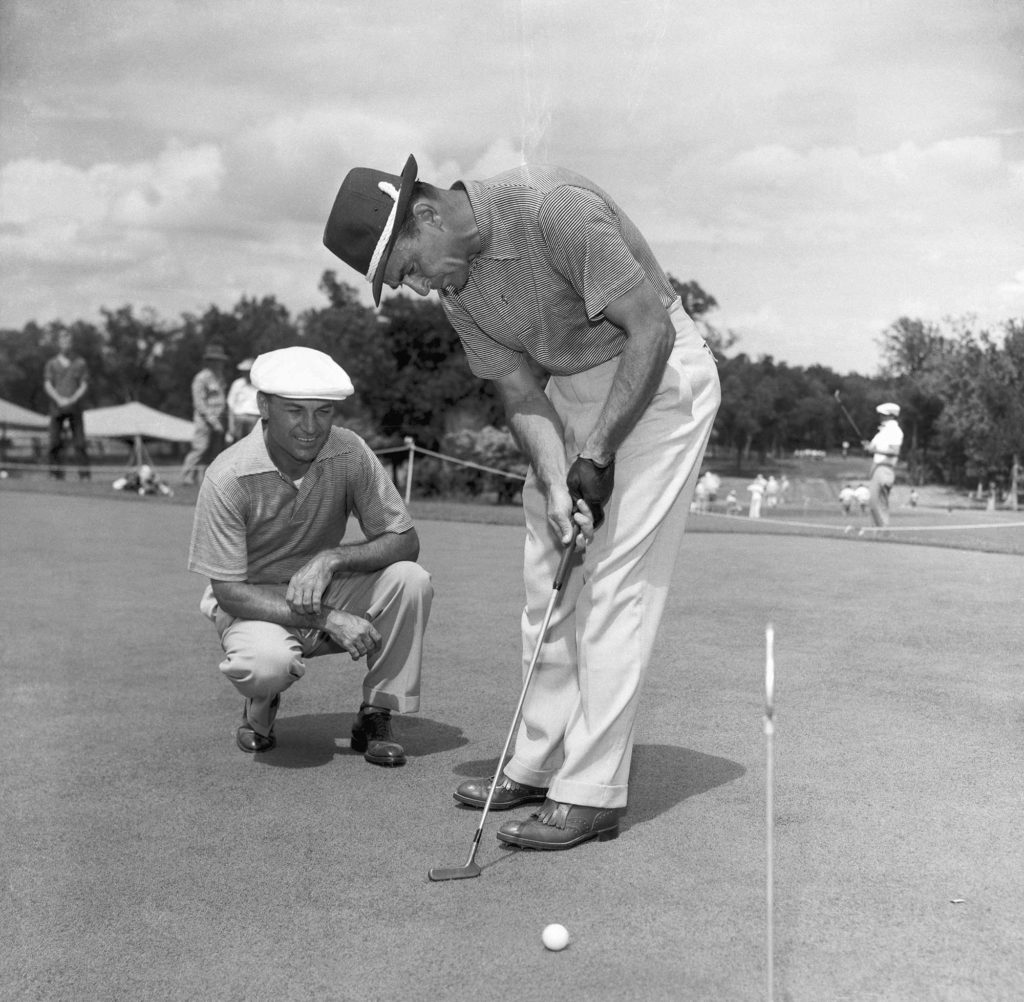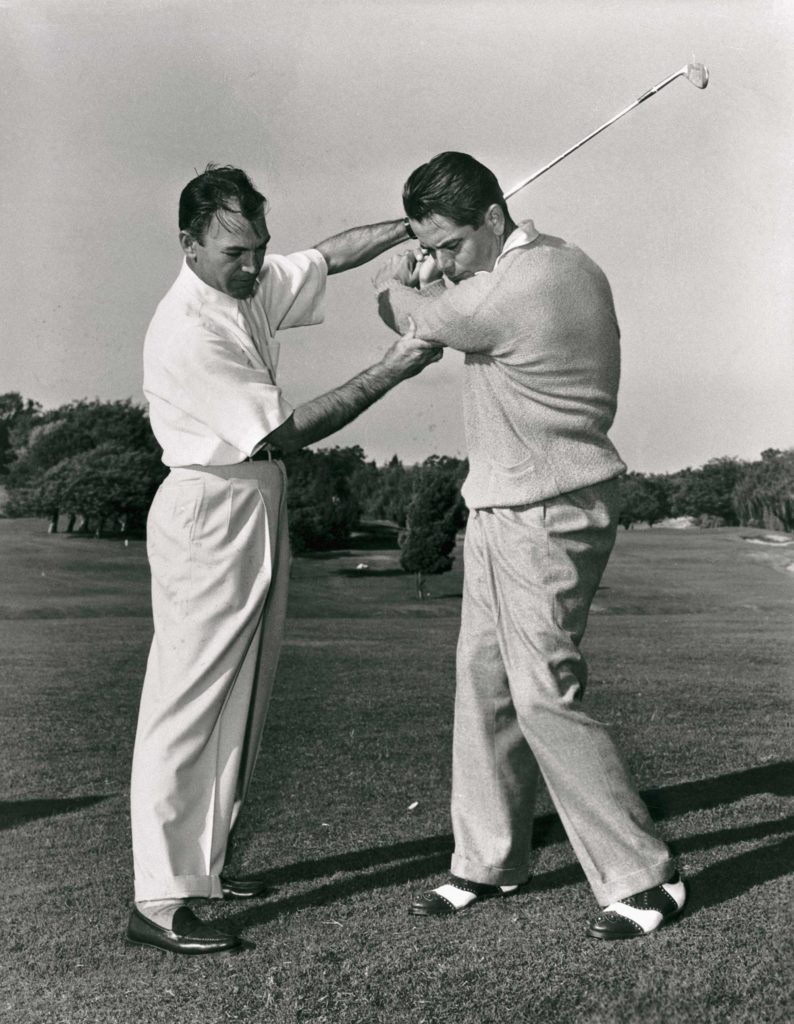A new e-book written by leading Australian instructor BRADLEY HUGHES reveals the secrets to Ben Hogan’s masterful golf swing.
I did not grow up in the Ben Hogan era. My golf idols were Greg Norman, Tom Watson and Seve Ballesteros. I had every corner of the globe covered with those choices. Australia, United States of America and Europe.
It wasn’t until much later in my golfing life that Hogan began to intrigue me.
Sure, I knew his playing record, his dress sense and the elegant looking swing. I had heard the stories of how Hogan would socially snuff out his playing partners during a tournament round, such was his pursuit for excellence.
I knew my golf history from devouring every golf book and golf magazine I could get my gaze upon. I knew about the car crash that nearly cost him his life in 1949. And the incredible comeback just over 12 months later to take the 1950 US Open at the esteemed Merion. I had the picture hanging in my room (who doesn’t!). A story so obscene that Hollywood scripted it and put Hogan’s story onto the big screen.
I knew about his one and only sortie to the Open Championship – although I knew it as the British Open. Carnoustie 1953. One attempt at the world’s oldest championship and one attempt was all he needed to secure his place on golf’s Mount Rushmore as a Grand Slam winner of all of golf’s Major championships.
It wasn’t, however, until 2011 – 23 years after I had begun my professional career – that I truly became inspired by Ben Hogan. Why then? That was the year I altered my path, switching my focus not into playing golf for a living any longer, but in becoming a golf instructor and helping others achieve the heights they had long aspired for with their own golf game.
Being a professional golfer only meant I needed to know what made my swing work to be successful and etch out a career. Being a golf instructor made me realise I had to dig deep into understanding other golfer’s swings. What better subject was there in this transition from player to coach than Ben Hogan?
Here I am – 12 years later – writing my third book about the golf swing. The first two books, The Great Ball Strikers and The 430 Path To Great Golf, have been a huge success. The feedback received from golfers the world over and the stories of their own improvement and understanding of the swing is truly the catalyst for this third venture.
I have been fortunate during the past decade to spend even more time with some of the truly great golfers of the world. I feel privileged to have also been able to help a few of them along the journey, as well as learn a little more insight myself.
Is it true that Ben Hogan had a secret? You can bet your life he did. All golfers have their own secrets that work. Some last. Some do not. Hogan’s secrets became more resolute as time passed.
In this book, Ben Hogan – The Secrets To His Success, you will learn what Ben Hogan discovered to build the most heralded golf swing in history. You will see the word “Secrets” in the title to this book. That is not a mistype. No one secret can be enough to propel a golf swing to the heights that Hogan climbed.
There are several secrets. The basis of the secret has been discussed in every locker room at every golf club across the country. The secret has been written about and fought over on the internet golf forums of the world. The secret has never been explained in such detail as the account in this book. The “secrets” can be yours to learn and strive for – if you follow closely and dedicate the time necessary to include them as your own. I have no doubt you will enjoy Ben Hogan – The Secrets To His Success. Here’s a little taste of what to expect.
–Bradley Hughes
getty images: Bettmann, Hulton Archive
▶ ▶ ▶
“Reverse every natural instinct and do the opposite of what you are inclined to do, and you will probably come very close to having a perfect golf swing”
Golf instructors and aficionados the world over have declared Ben Hogan’s instruction book The Five Lessons – or Modern Fundamentals Of Golf, as it has also been titled – the No.1 reference to golfing excellence.
I am sure that title is dedicated more through the love affair with Hogan’s golf swing and the published words giving an inside look at what Hogan felt to produce that swing than with the content itself. That is not to assume the swing autobiography isn’t enthralling to read and put into practice. The missing link with much of the book is Hogan. While writing verbatim about his instincts and swing goals, he glazed over several important keys that needed to exist for his words to be executed correctly.
One could also insinuate that Hogan may have also been thinking, I worked it out for myself so others should do the same. Listening to anecdotes from contemporaries and biography literature, Hogan worked extremely hard for everything he got from the game. Not just with the golf swing but also with the mental process and the way he altered his equipment to help solve the hook that plagued him in his early years. If this is the case, then it could also be fair to assume he wasn’t forthcoming in handing out all the information and suggested golfers also use their own self-discovery along the journey. On the other hand, Hogan also admitted if he were to write a full comprehensive instructional book it would have been 700 pages long! So maybe he just decided to leave a little bit out.
Even with my own instruction, giving all the answers or clues isn’t the major operative. Self-discovery by the golfer themselves is a key component to betterment. Even today I don’t see my PGA Tour players nearly as often as many other instructors do. My plan is, and has always been, to give the golfer the biomechanical movements through our discussions and via the drill experience. That way, a lot of the work and improvement then comes as a result of their own questions and own awareness from training the same Hogan dynamics. The Hogan swing itself is not an attainable goal. The dynamics are the blueprint to allowing the golfer to forge their own aesthetics, while living in harmony with the motions of balance, forces, pressures that evolve and revolve throughout the time a golf club moves in the space around them.
▶ ▶ ▶

“We have a testing machine here at the Hogan Company – me!”
Several observers of the game – players, instructors and writers – by their own admission desire the golf swings of Ben Hogan, Sam Snead and Byron Nelson, yet on the other hand consistently claim that the old equipment was poorly designed.
The reality is modern clubs are generally too light, too upright in their lie angle and contain too much offset. Golf swings suffer from that. A proper golf swing can hit the ball straight, far and with authority no matter the equipment.
Nelson was once questioned how much better he may have been if he had played with the modern equipment. He responded, “No better – the sweet spot is still there right in the middle of the face”.
Great ball-strikers from eras past loved high-spin balata golf balls because they could manoeuvre the ball sideways, spin it in certain directions and have at their disposal a more sophisticated palate of golf shots. It comes as no great surprise that Tiger Woods continues to play the highest spin ball possible to articulate his shot-making skills.
Hogan’s personal set of clubs were heavy and much flatter in lie angle than today’s revolutionary clubs.
In his book, Hogan stated that one of the turnarounds for his first PGA Tour win, the North & South Open, was using an extremely heavy driver that Byron Nelson had gifted him. The driver Valerie Hogan gave to the World Golf Hall of Fame from his 1953 Triple Crown season weighed in at an astonishing G2 swingweight.
If you can’t feel the clubhead then the swing is more prone to move away from the swing arc and control goes out the window. Heavier clubs create more resistance that transfers into the hands. Everyone states the hands control the swing and that feel originates from the hands. So why use a club that doesn’t embrace this?
Wielding a heavier club does take more strength, which is attainable just from the process of practising with them. It also enables better distance control, which truly is the heart of the matter. Doug Sanders told me, “I don’t care if you hit your 9-iron 125 yards or 150 yards, just be sure to hit it the same distance each time”. In other words, distance control is much more important than distance, especially with the iron approach shots.
If Hogan is your goal, then the first step is do what Hogan did. That starts with setting up your clubs properly. Flat, heavy, stiff – and something that grants you feedback so the brain can process the information correctly. This leads to improvement much quicker.
If you don’t like Hogan’s swing and think his style of play is outdated, archaic or irrelevant in today’s modern game, then choose a different path. Tiger may be a better option. But if you want Hogan, you need to step into his arena and associate what you feel with the same tools he worked with.

▶ ▶ ▶
“The average golfer’s problem is not so much a lack of ability as it is a lack of knowledge what he should do”
There are many golf teachers that won’t play with their students. Why? Because they don’t play anymore, and they don’t want to risk their reputation. The argument is that they teach and don’t have time to work on their swings. Personally, I now understand one should never take a lesson from an instructor that on occasion would not have the ability to beat you on a golf course. I know that sounds harsh, but golf is a lot more street smarts than book smarts.
As far as internet forums, most people would be shocked if they actually saw the golf swings of the “expert” posters. These people are not going to have much idea what I am talking about, because their frame of reference is so far away from mine that we might as well be speaking different languages. Not so different from the movie “Mars Attacks!” for those who have seen it. It shows how dangerous miscommunication can be and is a hilarious movie.
While most of these posters are probably filled with good intentions until you can see their golf swing or know their golfing pedigree, I wouldn’t pay an ounce of attention to their
ideas. We really need to see that to
know where they are coming from with
their concepts.
My days on internet forums were quite bizarre. I often had ‘experts’ bring all weird and wonderful arguments about what Hogan or others did. A few of them actually posted their own swing and it was clear that no amount of discussion was ever going to convince them otherwise. Steep swings. Upright clubs. Perimeter-weighted oversize heads. It’s obvious they would never understand the swing – they can’t. The pressures won’t manifest into the correct parts of the body. They won’t be felt and often won’t even exist in their swings. It’s “Mars Attacks!”.
▶ ▶ ▶
“The ultimate judge of your swing is the flight of the ball”
This picture of Hogan [above] may well be my very favourite. It practically shows us the “Secret Of Golf”. I could send this snapshot out into the airwaves of social media and ask for observations about what secret is being displayed. Most people would have no idea what I am talking about, and the correct answer may be supplied once in 500 responses. Even then, it may come from someone I have discussed the topic with.
Do you see it? Hogan is displaying the classic “hitting” into impact. Making those hands work and speed up like The Little Engine That Could. How do we know this? The shaft… The bowing of the shaft backwards gives it all away.
Hogan is accelerating the club into the impact zone – bringing a pre-stressed shaft into the final assault on the ball. This can only be done with hands acting likes motors and firing. The clubhead is still effectively loading. Lag pressure still intact. Maximum clubhead speed not yet reached. This is aided by Hogan’s intention of striving for the post-impact to be stronger or to beat the urge of hitting too soon.
Passive hands and “swinging” can accomplish a similar look by aiming the hands forward but that is a disguise. This swing at the ball is the pivot stall dump of pressure downward that makes impact the last true force involvement of the swing. Everything folds and slows down, and pressure is lost. Hogan did it the masterful way. The stuff of Gods and one of the elements that set him higher up the chain of ball-strikers than any before or after him.
Whatever angles a golfer loads on the downswing must be gotten rid of before impact. The left arm and shaft need to align, and this can only be done actively. This is why I am hellbent on stopping my students from leaning the shaft forward when they train drill one. Active release and lining up of the shaft with a slight supination or leading left wrist is the compressed power of hitting slightly down on the ball with the middle of the club. We don’t want to be at the mercy of perfect timing by aiming the clubhead or the hands.
Don’t ever be fooled that impact means the show is over. We need to sustain the pressure on the shaft to minimise any chance of the club slowing down due to forces of clubhead meeting the ball. Only the pivot like a wall of steel can sustain that shaft pressure deep into the follow-through. So, the more pivot the golfer can save for post impact, the better this occurs. No flipping of the hands or club will eventuate once you can release the club with the three right hands – rotationally down and working left – and then add the pivot for the double whammy of release.
A flat left wrist at impact – just forget about trying to do it. The rotation of the forearms uncocking the wrists will correctly place that alignment into impact by acceleration of force and a proper Hogan release. Trying to create it by itself would be like placing two lit cigars behind the rear wheels of your
car in the hope that will get your engine to start.

Ben Hogan – The Secrets To His Success, written by Bradley Hughes, is available for purchase ($US24.99) and download at bradleyhughesgolf.com. Online lessons with Hughes are also available.
Feature image: Getty images: Bettmann





